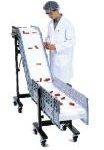 Selecting and installing clean room conveyors can dramatically improve your productivity. Therefore, understanding your needs and recognizing the attributes of the conveyor systems you are considering is imperative.
Selecting and installing clean room conveyors can dramatically improve your productivity. Therefore, understanding your needs and recognizing the attributes of the conveyor systems you are considering is imperative.
When analyzing clean room conveyors, you should consider initial cost, total cost of ownership, maintenance needs, noise levels, energy consumption, flexibility and clean room classification.
 Total Cost of Ownership
Total Cost of Ownership
An important step in evaluating the purchase of clean room conveyors is determining the total cost of ownership. A total cost of ownership investigation takes the purchase beyond the initial capital investment and installation. Questions to be considered during the investigation should include: How will energy costs affect the long-term return on investment? What are the preventative maintenance requirements? How often and at what cost will the belt need to be replaced? What is the expected lifespan of the equipment?
Answering these questions will help you evaluate the best conveyor choice for the long-term.
Initial Cost
Initial cost of the conveyor may or may not be indicated by the clean room classification rating received for the conveyor system. Look for a “standard” conveyor that meets your clean room environment needs with the least or no additional cost to the conveyor.
Flexibility
How flexible is the conveyor in length, configuration and the addition of accessories? In industries where production needs can suddenly change, or where sudden innovation is common, a conveyor with flexibility helps manufacturers employ rapid and proactive methods to meet the demands of new developments and manufacturing changes. The ideal conveyor will offer the flexibility for easily changing length and angle configurations. The conveyors should also allow for easy adaption of clean room accessories and components such as HEPA filters, tunnel enclosures, ionizers and hermetically sealed entry/exit gates.
Clean Room Classification
The most critical requirement for a conveyor in a clean room environment is, of course, its clean room classification. Clean room conveyors rated to a class 100,000 are readily available, but for processes requiring true contamination control, class 100,000 is well out of range. Indeed, a truly sensitive process will require a vastly stricter specification (down to class 1 in some cases), while other processes in the same facility require only class 100 or 1,000. Your range of clean room requirements should be considered when making your conveyor purchase. Why purchase a class 1,000 conveyor when you can purchase a Federal Standard 209D Class 1 rating conveyor — for virtually the same price — that will meet all of your clean room conveying needs?
Noise Levels
Noise can be a contaminant in the clean room. Although maximum permissible exposure limit for noise set by OSHA is 90 dBA, a range of 50 to 60 dBA is actually considered comfortable. There are no conveyors that can be run in complete silence. With all the working and moving parts that most conveyor processes involve, noise is inevitable. But, the level of noise produced by conveyors runs the gamut and can easily exceed 70 dBA. Therefore, when it comes to noise levels, remember that there are extremely quiet conveyor systems available that operate below 60 dBA.
Maintenance and Upkeep
Another consideration relates to the maintenance and upkeep required by each conveyor system being considered. How often, how easy and what is required to maintain and keep the conveyor clean? Look for conveyors that use FDA approved modular plastic link style belting and brushless DC motors. Plastic link style belting is self-lubricating, requires no maintenance, and is easy to clean and repair. Positive sprocket drive and tracking with the plastic link style belting eliminates slippage and edge damage doing away with the need for belt replacement. Brushless DC motors include maintenance free gearboxes that are grease packed, require no lubrication, and eliminate the potential of leaking oil.
Energy Consumption
No matter the requirements of the particular conveyor, most conveyor manufacturers use the same large horsepower motor on all of the conveyors they manufacture. Look for a conveyor supplier that utilizes the most energy efficient motors based on each conveyor application. Lowering the kilowatts used not only saves money, but reduces the carbon emissions during the making of electricity. For your clean room, consider brushless DC motors that meet clean room standards by not emitting carbon like comparable brushed motors.
Taking the time to choose the right conveyor for clean room conveying offers numerous advantages for manufacturers. Look for a supplier that provides Federal Standard 209D Class 1 rated clean room conveyors, offers increased conveyor flexibility and reduced total cost of ownership at standard conveyor prices.
Subscribe to our E-News and stay informed!
